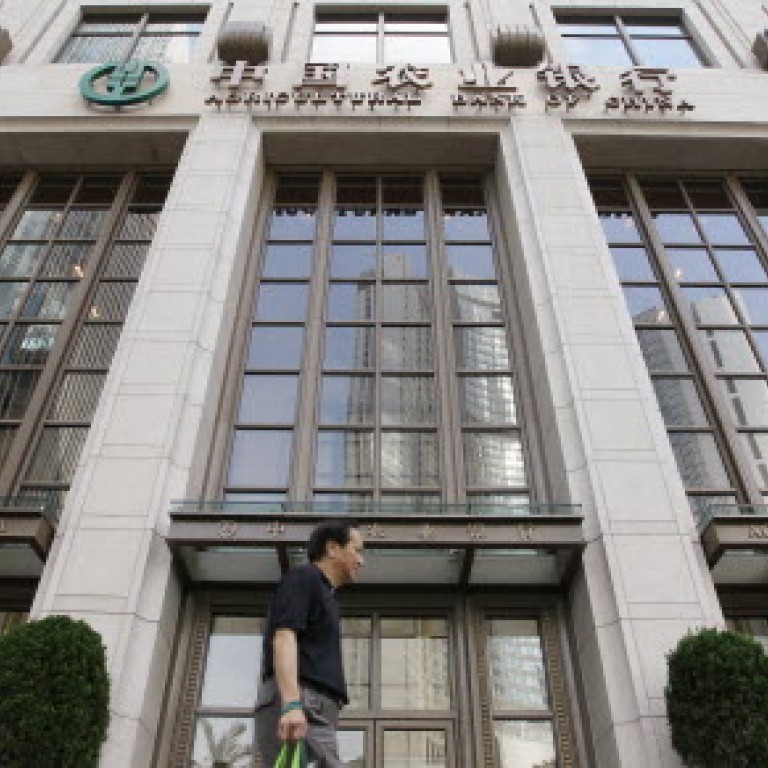
Capital base of Chinese banks not as strong as bosses claim
Lenders' capital-to-asset ratios do not adequately reflect exposure to off-balance sheet loans made through shadow banking channels
Judge by the headlines and it looks as if China's banks are in rude financial health.
In recent days, the country's big state-owned banks have announced half-year profits up 12 per cent or more on the same period in 2012.
What's more, a bigger proportion of those earnings came from fees, rather than interest income.
Even more reassuring, bad loan ratios remain low at around 1 per cent or less, with generous provisions covering non-performing assets between two and three times over.
And on top of that, China's banks are handsomely capitalised, typically boasting capital to risk-weighted asset ratios of 13 per cent or more, and top quality core capital ratios in excess of 10 per cent.
So, at first glance, it may be surprising that yesterday Agricultural Bank of China told analysts it would issue preferred shares over the coming months, as well as sell subordinated debt, in order to pad out its capital base.
It is hardly surprising that Chinese banks are … scrambling to raise fresh capital
On closer examination, however, the drive by Agricultural Bank, as well as other smaller banks, to raise fresh capital doesn't look quite so strange.
China's economy is undergoing a slowdown, with growth easing from double digits to rates of 7 to 8 per cent.
After the growth splurge of recent years, the deceleration is badly needed. Even so, the experience will be painful.
Credit rating agency Standard & Poor's points out that the slowdown is coming hard on the heels of a period in which the debt of China's biggest corporations ballooned two and a half times in six years.
Now, with margins under pressure and cash flows weakening, many Chinese companies, especially those in sectors suffering overcapacity - like building materials, coal and metals - will struggle to service their debts. Weaker companies are likely to default, warns S&P managing director Christopher Lee.
Inevitably, that will mean an increase in non-performing loans. So far, the projections look relatively modest. S&P is forecasting a rise in bad loan ratios to between 2 per cent and 3 per cent by the end of this year.
On the surface, it looks as if China's banks should be able to absorb the increase, given their conservative forward provisioning and comfortable capital cushions.
Unfortunately, however, there are some good reasons to worry that the outlook may be considerably bleaker than the official figures imply.
For one thing, many observers believe China's banks have disguised their real levels of bad assets by rolling over loans to zombie borrowers who cannot afford to repay their debts.
Count those loans as non-performing, and it is likely the true ratio of bad loans could rise towards 10 per cent over the next couple of years.
Then there are doubts about whether Chinese bank capital ratios are really as high as the bankers claim.
Over recent years, China's banks have bulked up their capital bases by issuing hundreds of billions of yuan of subordinated debt.
The trouble is that roughly half of that subordinated debt is held by other banks. Under a strict interpretation of the international rules, that means it should be disregarded when calculating capital adequacy ratios.
Exclude this cross-held subordinated debt, and, according to a study by Xu Lei and Ron McIver at the University of South Australia, overall capital adequacy ratios at Chinese banks fall by the best part of a percentage point.
On top of that, there are concerns whether the asset side of banks' capital-to-asset ratios adequately reflect banks' exposure to off-balance sheet loans made through China's shadow financial market.
Although the banks are not legally responsible for these loans, many of which have been repackaged and sold to savers as wealth management products, it is likely they will be forced to cover savers' losses should the borrowers run into trouble.
Factoring in this exposure, S&P's analysts estimate that the true core capital to risk-weighted assets ratio for China's top 50 banks is not the 10.5 per cent official figures imply, but more like 5.5 per cent.
For the weakest commercial banks, they believe this ratio could easily drop below 4 per cent by the end of next year.
Seen in that light, it is hardly surprising that Chinese banks are now scrambling to raise fresh capital, even as they are busy announcing robust half-year profit figures.

